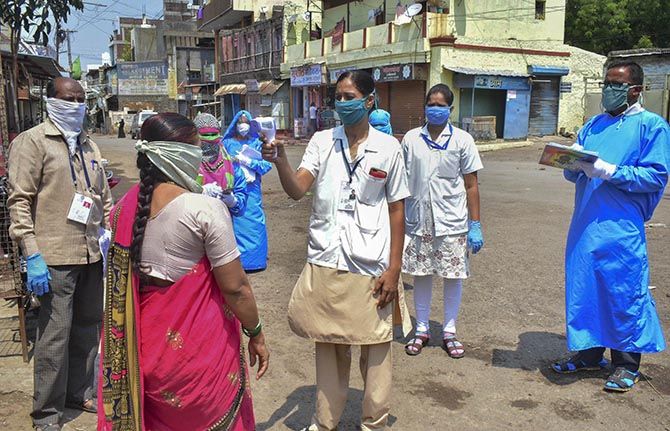 | « Back to article | Print this article |
As with the Spanish flu, the world must be ready for a second and third wave as this start-stop-start-stop response plays out, recommends Rahul Jacob.

One of the most popular videos on Twitter has been of a sixty-something PhD in quantum chemistry calmly explaining on Wednesday night how even seemingly tiny increases in the rate of infection of the SARS-CoV-2 could potentially overwhelm intensive care units capacity in her country.
Anything below 1 means the the virus is under control while anything above -- that is, one infected person is passing it on to more than one other person on average -- is an indicator that the epidemic is still progressing.
German Chancellor Angela Merkel was highlighting that if the reproduction number rose to 1.1, Germany's health system would be swamped by October; if it rose to 1.3, that would happen in June.
As countries across Europe grapple with relaxing social distancing measures -- Spain has allowed some construction and factory work to restart while Denmark has reopened primary schools -- governments everywhere will be watching that reproduction number in the manner that seismologists monitor the Richter scale in the midst of an earthquake.
Germany, the Covid role model in the West, will allow the partial reopening of schools in early May.
As India's de facto curfew is eased selectively for some industries, governments everywhere face the hardest of policy choices.
Harvard's Marc Lipsitch, one of the world's leading epidemiologists, observed recently, that the risk of 'miscalibrating' the reopening of commerce could end up overwhelming health care systems and damaging the economy.
Many governments are likely to use a trial-and-error method, where limited easing might be followed by tightening restrictions again if infections spike.
As with the Spanish flu, the world must be ready for a second and third wave as this start-stop-start-stop response plays out.
Singapore, which saw a jump in infections because of a continuing outbreak in tightly-packed migrant worker dormitories, has had to tighten in the past fortnight.

The problem in India is that testing remains very low by global standards.
The Indian Council of Medical Research has at least massively increased the importing of test kits.
Epidemiologist Gautam Menon in a conversation with students at Krea University suggested that testing for antibodies -- to determine whether people have been exposed to the virus -- could be carried out in all of India's districts, using sampling methods in the manner that election pollsters do.
He pegged the number of tests required at 720,000, 'not an outrageously large number'.
Without sophisticated sampling, India's testing remains skewed to so-called hotspots, citizens with recent international travel history and people reporting symptoms.
A study from China confirmed that more than 40 per cent of people who tested positive had been asymptomatic, underlining again that temperature screening measures used by India so energetically, at places ranging from the ministry of finance to supermarkets, are inadequate.
A COVID-19 Tracker in the Mint newspaper shows that five Indian cities -- Mumbai, Delhi, Indore, Jaipur and Ahmedabad -- account for a third of confirmed cases nationwide.
Whether this reflects higher levels of testing in these cities or a more rapid progression of the epidemic remains to be seen.
Part of the calibration effort might be to relax physical distancing by allowing younger age groups to return to work.
This intuitively makes sense because younger people withstand the virus better but is complicated in poor countries where grandparents live with younger family members in cramped conditions.
Without adequate safety nets for the working poor, countries like India may soon have no choice, however.
The Financial Times economics commentator Martin Wolf warns that emerging economies would face a 1930s style recession with governments forced to take on more debt, monetise it and possibly deal with consequences such as high inflation.

In India, the rough-and-rougher policing of who is allowed on the street and bureaucratic overkill in haphazardly delineating what constitutes essential services has created food shortages and put the economy under a kind of house arrest, but done less for physical distancing.
Photos of crowded vegetable markets, say, or of outside the Bandra railway station in Mumbai where thousands of migrants assembled on April 14 hoping for trains to go home, suggest the lockdown has frequently jammed people together. (By contrast, Wolf, who lives in London, recently recounted a 'visit' by two of his grandchildren -- limited to banging on the windowpanes of his study and shouting out to him.)
In the densely-packed developing world, cost-benefits analyses of health-versus-economy trade-offs becomes impossible.
An early indicator is that India's exports declined by 35 per cent in March.
Allowing 80 per cent of export units in special economic zones to start work again may help.
However, our competitors for labour-intensive manufacturing had the benefit of a much less economically disruptive lockdown and were not already weakened by the 'comorbidities' of working capital shortages brought on by a chaotically managed goods and services tax.
Besides, global demand has collapsed. It is fashionable to alternately quote mythology and military metaphors in the face of this calamity.
But as the World Health Organization's regional director for Europe said, 'There are no quick wins.'
Even as an agnostic, I am praying that data-driven science and economics and a dose of luck guide us through this.